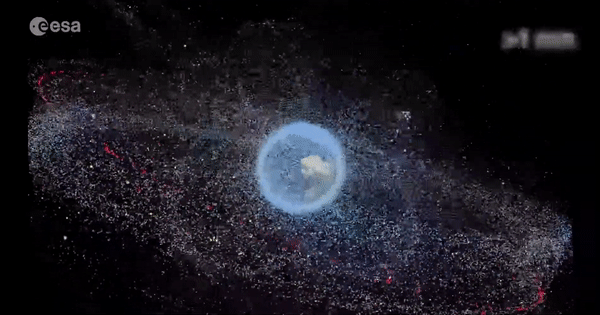6.500 Trägerraketen haben seit 1957 rund 17.000 Satelliten ins All gebracht, 11.500 davon befinden sich noch immer dort und davon sind wiederum 9.000 noch in Funktion. Über 640 Kollisionen, Explosionen und andere zerstörerische Ereignisse haben dabei 36.500 Schrottteile über 10 cm, 1 Million zwischen 1 und 10 cm und 130 Millionen von 1 mm bis 1 cm generiert. Die Gesamtmasse von Objekten der Raumfahrt im All beträgt etwa 11.500 Tonnen. Die meisten stammen aus Aktivitäten der letzten Jahre. Absehbar ist daher, dass die Raumfahrt der Vergangenheit und Gegenwart die Raumfahrt der Zukunft sehr bald verhindern wird, wenn nichts an der Situation geändert wird.
Mit statistischer Erfassung der zunehmenden Vermüllung jedenfalls wird es nicht getan sein, Grundlegendes ist gefragt. Das sehen auch die ESA und zehn ihrer Mitgliedsstaaten so, die jüngst die Zero Debris Charter unterzeichneten.
Am 6. Juni folgt auf der ILA in der Raumfahrthalle 4, eingeleitet von ESA-DG Aschbacher, Ex-Astronaut Thomas Reiter und BDLI-Vize Marco Fuchs um 12.35 Uhr der zweite Akt, wenn 38 Unternehmen und Institutionen aus wiederum zehn Ländern die freiwillige Selbstverpflichtung zur Reduktion bestehender und zur Vermeidung neuer Schrottberge im All unterzeichnen. Die Zeremonie ist für rund zwei Stunden angesetzt.
Nachfolgend die Zero Debris Charter im Originaltext:
Zero Debris Charter
Towards a Safe and Sustainable Space Environment
Preamble
We, those working towards a zero debris future,
Commending the efforts of the actors of the European and global space sectors committed to the advancement of space safety and sustainability;
Acknowledging the encouragement given to the European Space Agency by its Member States to implement a Zero Debris approach, by which it aims to stop generating space debris by 2030;
Recognising the role of the European Space Agency in the initiation and facilitation of this Charter, resulting from an open and collaborative process;
Recalling that international and national laws and regulations provide for the sole binding rules applicable to the conduct of space activities;
Establish this non-legally binding Charter as a major contribution towards space safety and sustainability, fostering a community of proactive actors working collectively towards jointly defined ambitious and measurable targets for 2030.
We, those working towards a zero debris future,
Concerned that the degradation of the space environment increasingly jeopardises the safety of space activities and risks the disruption of their benefits to humankind;
Conscious that the orbital space environment constitutes a finite resource and of the urgent need for more ambitious actions on space debris prevention, mitigation and remediation from all space stakeholders;
Convinced that meaningful improvements to space safety and sustainability can only be achieved through the cooperative efforts of a community committed to act towards jointly defined, ambitious and measurable targets for 2030;
Supporting existing multilateral and multistakeholder endeavours to achieve space safety and sustainability;
Determined to lead by example;
Paragraph 1. Guiding principles
Recognise the following principles as guiding our collective endeavour towards space safety and sustainability:
- Space debris should not be intentionally released during space activities and the unintentional generation of space debris should be minimised.
- Adverse effects of space debris, including, but not restricted to, their impact on the population, infrastructures and the Earth environment when re-entering the atmosphere, and on dark and quiet skies, should be anticipated and mitigated to the greatest possible extent.
- Constant and collaborative efforts should be made to improve our knowledge and understanding of the population of space debris of all sizes, our impact on it and its impact on us.
Paragraph 2. Jointly defined targets
Commit to collectively contribute to the progressive achievement of the following targets for 2030, within our respective abilities and constraints:
- The probability of space debris generation through collisions and break-ups should remain below 1 in 1000 per object during the entire orbital lifetime. A suitable aggregate probability threshold for constellations of satellites in the low Earth orbit region should be identified.
- Timely clearance of low Earth orbit and geostationary Earth orbit regions should be achieved with a probability of success of at least 99% after end of mission, including through external means when necessary.
- The casualty risk from re-entering objects should remain significantly lower than 1 in 10 000, striving towards zero casualty. A suitable aggregate risk threshold for constellations of satellites in the low Earth orbit region should be identified.
- Routine and transparent information sharing should be facilitated and active participation in strengthening global space traffic coordination mechanisms should be encouraged.
- Access to timely and accurate data on space objects down to a size of 5 cm or smaller in low Earth orbit and 20 cm or smaller in geostationary Earth orbit should be improved to enhance decision making capabilities for collision avoidance.
Paragraph 3. Functioning of the Charter
- Invite regular exchanges on our respective contributions towards the achievement of the targets defined in Paragraph 2.
- Encourage any entity demonstrating a strong commitment to advancing space safety and sustainability to join this Charter, without requiring the agreement of existing partners.
- Welcome the European Space Agency’s offer to maintain a public list of partners of this Charter and to provide regular opportunities for exchanges.
- Expect all partners to contribute to the promotion of this Charter.
- Invite all partners to collaborate on the next steps beyond 2030.
- Foster the development of relevant technologies and performance indicators that uphold the guiding principles and support the achievement of the targets.
Quelle Statistik:
https://sdup.esoc.esa.int/discosweb/statistics/#https://sdup.esoc.esa.int/discosweb/statistics/
